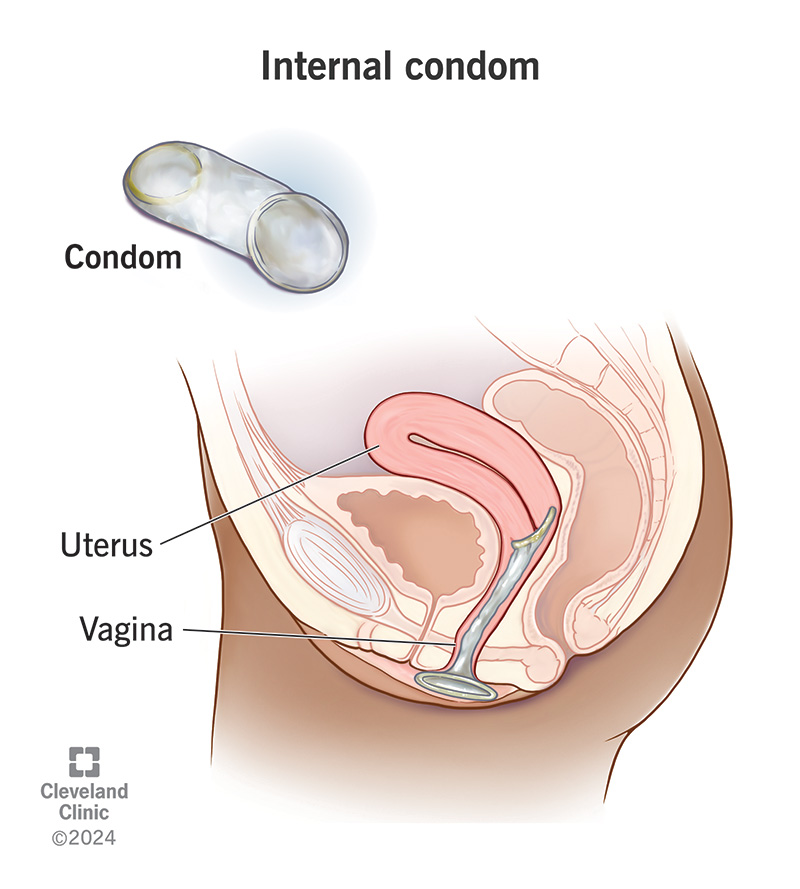An internal condom is a type of birth control that works by preventing sperm from entering your body through a vagina or anus. Unlike a typical external condom, internal condoms go inside your vagina or anus (during anal sex). They can also protect against sexually transmitted infections (STIs).
Advertisement
Cleveland Clinic is a non-profit academic medical center. Advertising on our site helps support our mission. We do not endorse non-Cleveland Clinic products or services. Policy

An internal condom (or “female” condom) is a pouch that you insert into your vagina or anus to prevent pregnancy and protect against sexually transmitted infections (STIs). It works by creating a barrier that prevents sperm and bodily fluids from entering your body. Unlike external condoms that are worn on the outside of a penis or on sex toys and accessories, an internal condom is worn on the inside of a vagina or anus.
Advertisement
Cleveland Clinic is a non-profit academic medical center. Advertising on our site helps support our mission. We do not endorse non-Cleveland Clinic products or services. Policy
Internal condoms are made of nitrile, which is a thin, soft plastic material. It has a flexible ring on each end. When inserting the condom, squeeze the inner ring (closed end) and slide it into your vagina or anus as far as it will go. If you’re using it for anal sex, you can also place the internal condom around a penis or sex toy.
The outer ring stays outside your vagina or anus. You may want to check periodically that the outer ring hasn’t slipped inside. This outer ring protects the skin around your vagina and anus from contact, reducing your risk of getting an STI.
There’s lubricant on both sides of the condom to make it more comfortable to insert. Make sure the condom doesn’t become twisted when you insert it.
Immediately after sex, twist the outer ring and gently pull the condom out.
You can insert an internal condom right before you have sex or up to eight hours before. They come in one size — the length is similar to an external condom, but slightly wider.
An internal condom may feel like other barrier birth control methods that go inside your body, like a cervical cap or diaphragm. It can initially feel like something is “stuck” in your body, but the feeling should go away. While they come lubricated, it might be helpful to use more silicone- or water-based lubricant when you insert one. This can make it more comfortable.
Advertisement
They are meant for one-time use. This means you need to throw it away right after you have sex or if the condom breaks. If you have sex again or switch to a different type of sex (like from vaginal to anal), use a new one. Reusing a condom increases the odds that they’ll leak, break or slip in.
You can purchase internal condoms at some online retailers or directly from the manufacturer’s website. The only internal condom approved by the U.S. Food and Drug Administration (FDA) in the U.S. is the FC2® Internal Condom.
Internal condoms are 79% effective in preventing pregnancy with “typical use,” or how most people use them. This rate is mostly due to people not using them properly and consistently. If you use it correctly every single time you have sex, the effectiveness can be as high as 95%.
This means internal condoms are slightly less effective than regular condoms, and a lot less effective than many other types of birth control in preventing pregnancy.
You can also use an internal condom with another form of birth control (like an IUD or pill) to further reduce your chances of becoming pregnant. But don’t use internal and external condoms at the same time because they can stick together and tear.
Keep an internal condom in the entire time you have sex. It might move around during sex. This is OK as long as the condom doesn’t slip out of your vagina or anus. If you have a partner with a penis and they slip out of the condom, you may increase your risk for pregnancy or STIs if body fluids are exchanged or if your partner has an STI and there’s skin-to-skin contact.
The condom may make sex a little noisier. Adding lubricant might help with this. Do not use oil-based lubrication, though, as it can damage the condom.
The pros of internal condoms are:
Some of the drawbacks of an internal condom are the same as those for an external condom — for example, the condom might break or tear. Pay attention to the expiration date on the package, too, and be sure to open the wrapper and insert the condom carefully so you don’t accidentally rip it.
Advertisement
Other cons to internal condoms include:
Navigating the world of birth control can be overwhelming. Hormones or no hormones? Pills or condoms? What’s important is that you have all the right information to make a decision that works for you.
Internal condoms are one of the many options if you want to prevent pregnancy, protect yourself against STIs or both. They aren’t the most effective option for safe sex practices, but they may still be a consideration for you. Ask your healthcare provider about internal condoms and other forms of birth control. They can help you make a choice.
Advertisement
Your birth control needs to work for you. At Cleveland Clinic, we help you find the right birth control option to fit your goals and lifestyle.

Last reviewed on 06/11/2025.
Learn more about the Health Library and our editorial process.